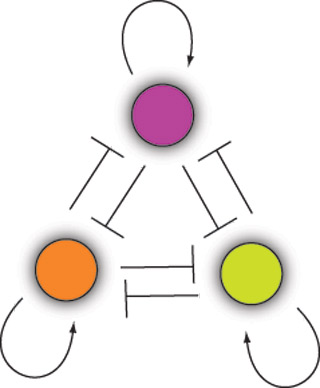
This illustration demonstrates a genetic network, a central concept in Systems and Synthetic Biology.
(Image by Hyun Youk. Used with permission.)
Instructor(s)
Dr. Hyun Youk
MIT Course Number
7.342
As Taught In
Fall 2010
Level
Undergraduate
Course Description
Course Description
A millennial challenge in biology is to decipher how vast arrays of molecular interactions inside the cell work in concert to produce a cellular function. Systems biology, a new interdisciplinary field of science, brings together biologists and physicists to tackle this grand challenge through quantitative experiments and models. In this course, we will discuss the unifying principles that all organisms use to perform cellular functions. We will also discuss key challenges faced by a cell in both single and multi-cellular organisms. Finally, we will discuss how researchers in the field of synthetic biology are using the new knowledge gained from studying naturally-occurring biological systems to create artificial gene networks capable of performing new functions.
This course is one of many Advanced Undergraduate Seminars offered by the Biology Department at MIT. These seminars are tailored for students with an interest in using primary research literature to discuss and learn about current biological research in a highly interactive setting. Many instructors of the Advanced Undergraduate Seminars are postdoctoral scientists with a strong interest in teaching.


